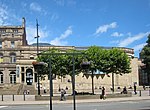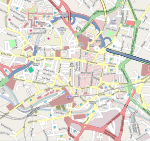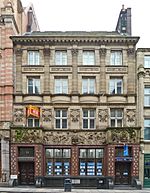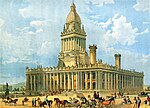Leeds War Memorial
Bronze sculptures in EnglandBuildings and structures completed in 1922Cenotaphs in the United KingdomMilitary history of West YorkshireMonuments and memorials in Leeds ... and 5 more
Outdoor sculptures in EnglandSaint George and the DragonUse British English from November 2013World War II memorials in EnglandWorld War I memorials in England

Leeds War Memorial stands on Victoria Square on the Headrow, to the east of Town Hall and to the south of Leeds City Art Gallery in Leeds, England. It was erected as a memorial to those who had fallen in the First World War. The memorial was designed by Henry Charles Fehr (1867–1940) and unveiled on 14 October 1922 by Viscount Lascelles.
Excerpt from the Wikipedia article Leeds War Memorial (License: CC BY-SA 3.0, Authors, Images).Leeds War Memorial
Victoria Gardens, Leeds Holbeck Urban Village
Geographical coordinates (GPS) Address Nearby Places Show on map
Geographical coordinates (GPS)
| Latitude | Longitude |
|---|---|
| N 53.7998 ° | E -1.54767 ° |
Address
Victoria Gardens
Victoria Gardens
Leeds, Holbeck Urban Village
England, United Kingdom
Open on Google Maps










